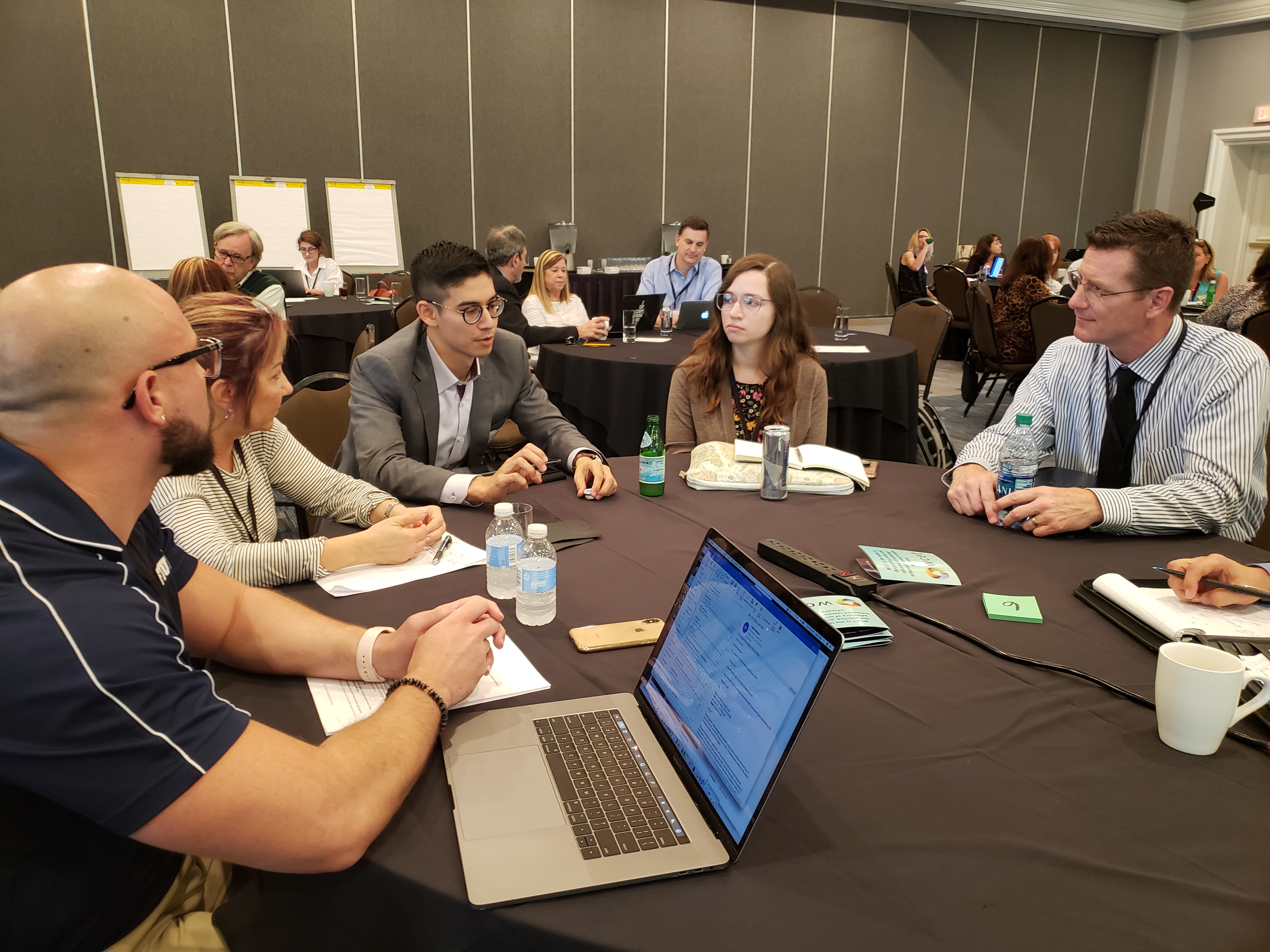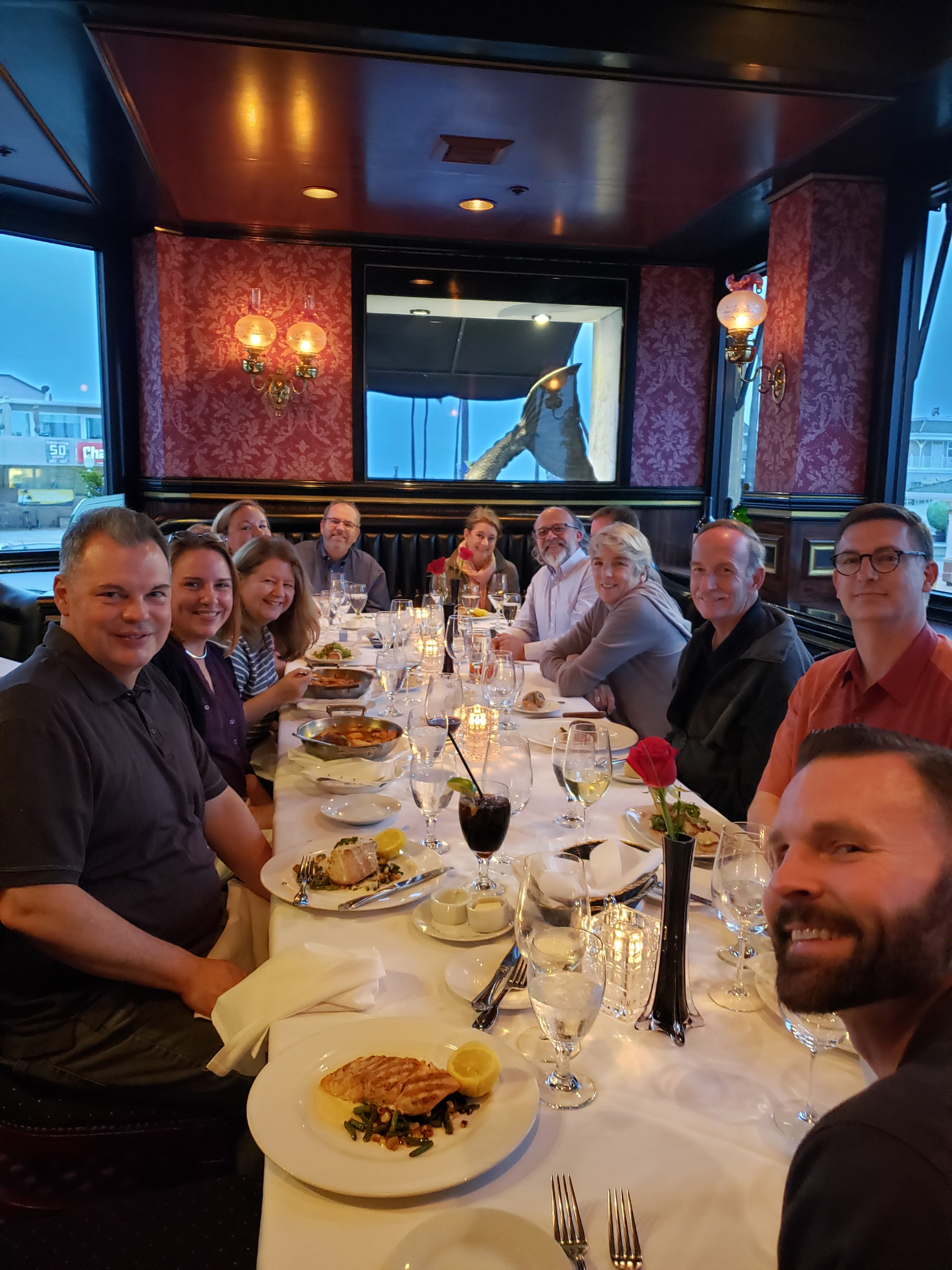Be Bold! Lessons from WCET’s Leadership Summit on Public-Private Partnerships to Meet Workforce Needs
Published by: WCET | 6/19/2019
Tags: WCET, WCET Summit
Published by: WCET | 6/19/2019
Tags: WCET, WCET Summit
Today we welcome Cheryl Dowd, Director of WCET’s State Authorization Network (SAN), who is here to give us a summary of WCET’s recent Leadership Summit. This year’s focus was workforce partnerships. You can view Summit information and resources.
Thank you to Cheryl for reporting on this outstanding event! Thank you to Megan Raymond and Mollie McGill for sharing the fun photos.
Speaking of WCET events… registration for the 2019 WCET Annual Meeting just opened! Register today!
Enjoy the read and enjoy your day,
Lindsey Downs, WCET

From the beginning to the end of the recent WCET Leadership Summit, attendees were encouraged to “be bold” when developing tools, processes, and interactions in higher education.
In the idyllic location of Newport Beach, CA, participants were challenged to share practices and brainstorm new ideas for providing learning opportunities through public-private partnerships to serve 21st century workforce needs.
Three main themes prevailed:
You may ask, how are WCET Leadership Summits different from other WCET events? The Leadership Summit offers the opportunity for a directed focus on a specific topic within a small group setting. The attendees interact to tackle a pressing issue in higher education. The intent is an action-oriented event that draws leaders in higher education from a variety of institutions and organizations to discuss and brainstorm how institutions can remain competitive to educate students today and, in the years, to come. The attendees are encouraged to develop action items for implementation at their institution or organization.

The event opened with Don Fraser, Director of 21st Century Skills Badging with the Education Design Lab, setting the tone by inspiring and motivating the attendees to “be bold” in this everchanging world of higher education. He expressed that:
We must act with urgency to consider the hard questions of what workforce says we need and what we as educators must provide. Not only for today, we must consider possible changes in this country and the world in the next thirty years.
Don asked us to consider how we will react to a variety of changes in higher education including the recent upsurge of college closures. In reaction to changes higher education must be “better, different, and move boldly.” The plan to manage the change is in the following three notions:
Casey Sachs, Deputy Assistant Secretary for Community Colleges, U.S. Department of Education, provided our next session. Ms. Sachs shared that it is the role of post-secondary education to encourage mutually beneficial industry partnerships. The focus of this session was on understanding the needs of the community. Ms. Sachs expressed the value of a local needs assessment to determine the programs that fit the community and reminded us that institutions may need to consider discontinuing programming that the community no longer needs. Additionally, she expressed the benefit of community interaction to pool resources to manage the program needs for the community.
We were challenged to measure success from a variety of perspectives including: students, business and industry, the economic development office, workforce development office, K-12 schools, and the community colleges. We were urged to consider success when our outcomes are aligned with our initiatives. Does graduation provide readiness for jobs? Should there be more opportunity for apprenticeship and mentorships?
Finally, we addressed the idea of competitiveness of our community to attract companies. Companies use a variety of factors when choosing a location. The tool ZoomProspector.com analyzes the community to determine whether it is a fit for them. The tool not only is useful to companies but would also provide necessary information to the community to determine how it can become more competitive. The information may include education attainment and opportunities for training in the community.
Considering that partnerships are beneficial to ongoing success in higher education, we were given the benefit of four different panels to describe different types of partnerships, recent lessons learned, and the value of partnerships:

The panels gave different perspectives of their association. The goals of partnerships are to reduce barriers to education, customize learning, and provide a greater focus on life-long learning. A recurring theme to the panel presentations was the assessment of the community needs for students and the workforce. More than one panel member suggested that skills in the workforce are in continuous need of enrichment as there is a “shelf life” to the skills learned in a degree program. Partnerships can be beneficial to continuous learning as skills in the marketplace evolve.
While we focused on the benefits of partnerships, we also discussed the possibilities of pitfalls. One panelist expressed the old adage: if you want to go fast, go along; if you want to go farther, have a partner. However, another panelist expressed the challenges that can occur around the areas of trust and transparency. To battle the trust concerns, experts suggested that consistency on the part of each partner offers the opportunity to build trust. Additionally, both partners must be aware of regulatory requirements and consumer protection.

Throughout the day, in addition to these presentations and panels, the attendees were given opportunities to participate in small groups in which they could learn from one another. One such session was a discussion about building short and long- term actions based on an assessment of the current status of higher education. Another small group session offered time to reflect on the panels, to ask follow-up questions, and to find potential collaborators.
Our second day started with an energetic session to consider steps to develop public and private partnerships that work. Susan Lupo, Senior Policy Associate, Corporation for a Skilled Workforce, led the attendees to consider how to build a business model to determine what it is being provided/sold. She encouraged us to understand that higher education institutions can be seen as employers and we may wish to contemplate whether our students are achieving the level of skills we would wish them to have as our employees.
We then participated in a very practical session about building on strengths and finding opportunities for collaboration and growth. Don Fraser once again led us through a view of innovation that has a “Human Centered Design Process.” Don shared an Innovation Assessment for us to review our practices, abilities, and strengths and weaknesses to focus our attention on what would best create opportunities for our students. As an example of creating opportunities to build skills, Don shared Education Design Lab’s, 21st Century Skills Badges.

The Summit concluded with a thoroughly engaging scenario-based session on institutional planning for the careers of tomorrow. Maria Anderson, CEO and Co-Founder of Coursetune, supplied each table with a specific crisis that that was to have occurred in the year 2020. Each table is considered a leader who navigated the crisis and, in 2030, is sharing with others how she or he handled the crises and was successful, despite the odds. This was a wonderful session. Some of the scenarios seemed wild, but, as Maria shared, she has removed a few scenarios from her presentations because they have already happened. The scenarios included the creation of a “kodak memory pill” and how to manage the advantage given by people who could gain access to this medical advancement. A few other scenarios were based upon the creation of new careers including healthcare brokers, insurance paramedicals, and providers of resettlement services for refugees. Another scenario was based on a new regulation that required 75% tuition reimbursement if the student was not employed within the area of the degree within two years. The responses by the attendees, while humorous at times, were thoughtful and forward thinking. This activity reminded us to be agile as we consider the future of higher education. Quite often we were asked why we had to wait for a crisis to do the right thing for students.
Overall, the Summit provided excellent direction and provocative thought as institutions and organizations determine what is next for higher education and what are our next best steps to partner and meet student and workforce needs.
You may wish to review the session materials on the WCET Website 2019 WCET Summit Page as well as read the quotes and comments from our attendees on the twitter hashtag #WCETSummit. While this year’s Summit is over, we’re gearing up for our Annual Meeting this fall in Denver, CO!

Cheryl Dowd
Director, State Authorization Network
WCET – the WICHE Cooperative for Educational Technologies
cdowd@wiche.edu
